Inflatable kayaks are becoming more and more popular, but are they safe in the ocean? Some people believe that they are not because they can easily be punctured.
Others believe that they are just as safe as regular kayaks. So, which is it? Are inflatable kayaks safe in the ocean or not? Let’s take a closer look at this question and find out.
Not all inflatable kayaks are safe in the ocean. The water flow and pressure in such a large water body are high, and not many inflatable kayaks can withstand it. Fortunately, inflatable kayaks for use in the ocean exist, and we will highlight their features.
Read on to get a detailed response concerning taking an inflatable kayak out in the ocean and safety tips when kayaking in the ocean.
Table of Contents
Are Inflatable Kayaks Safe In The Ocean?
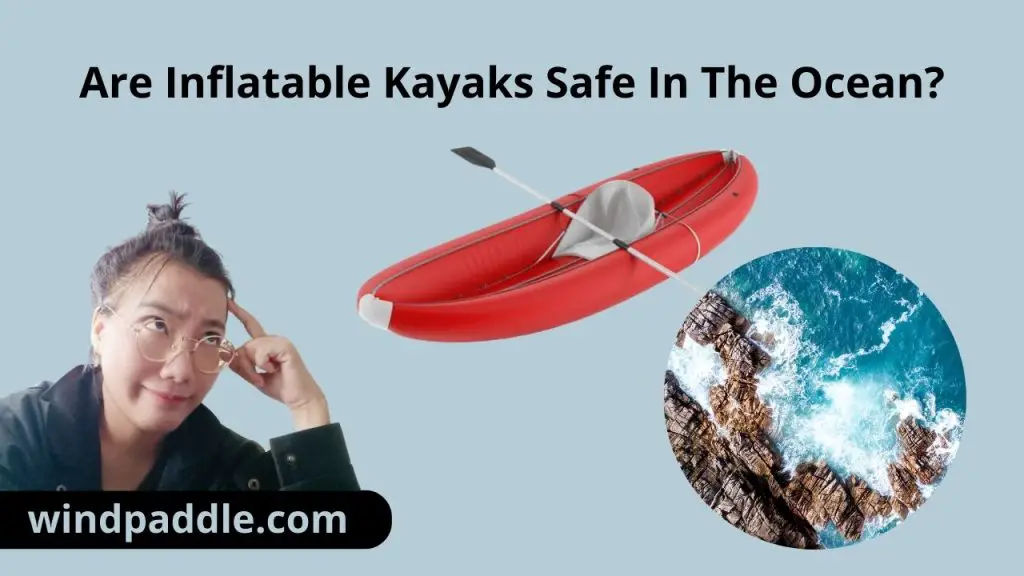
Yes. Inflatable kayaks are just underrated but are not far behind the other types. Some are designed and built to withstand conditions at sea. The modern ones can be paddled in almost every situation.
Inflatable kayaks are still stable in the ocean. And even if the water gets rough, you can still safely paddle to the shore. However, you should choose long and wide boats that can stand the waves. Narrow ones can succumb to strong water currents and become less maneuverable.
Inflatable kayaks are more stable and rigid than the pool toys you often interact with. Some are designed with metallic bases to improve the structure’s integrity and stability.
Besides, most inflatable kayak manufacturers use multiple layers of wear-resistant materials. The vinyl, polyester, Hypalon, or Nitrilon commonly used in the construction can withstand abrasion and resist puncture.
Features of Inflatable Kayaks
Inflatable kayaks are expertly designed to withstand weather elements and stressful forces it faces at sea. They are made puncture-resistant, stable, maneuverable, and durable. Let’s get the details of each feature to better understand an inflatable kayak and what it offers.
Durability of Inflatable Kayak
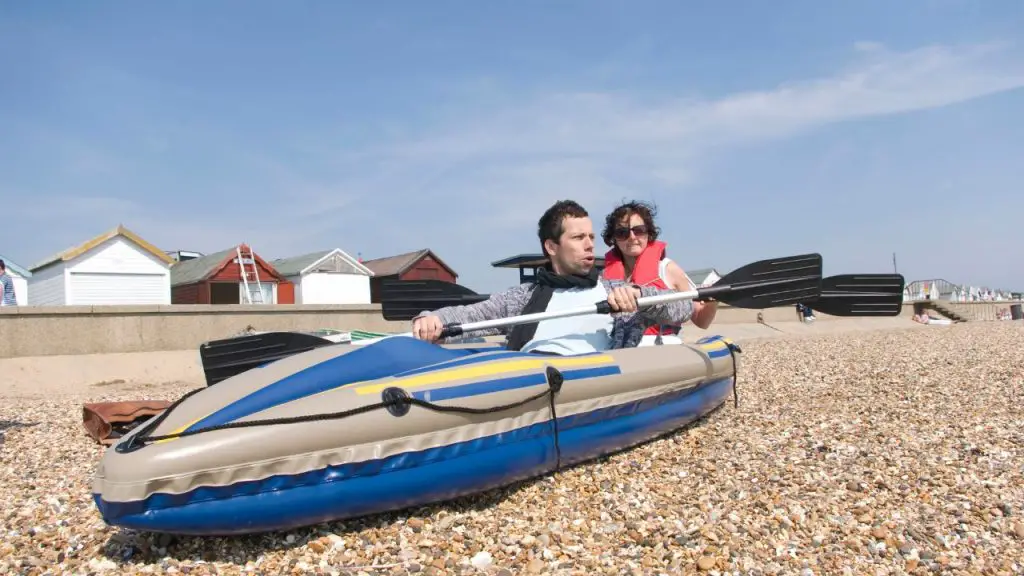
Many people think of pool toys when you mention inflatable kayaks to them. That is just a misconception, as the two are a world apart. Inflatable kayaks are as durable as their hard-shell counterparts.
As mentioned, kayaks are made of multiple layers of materials that resist external elements. You don’t have to worry about how durable your kayak will be when you take it out in the ocean. Even inexpensive entry-level inflatable kayaks are made of vinyl and polyester and hold on quite well in rough ocean waters.
Some inflatable kayaks are covered with durable fabrics and feature layers of synthetic rubber to make them even more durable. But if you are looking for a premium quality inflatable kayak, choose one made of Hypalon and Nitrilon. These materials are more rigid and durable, though you have to spend more on them.
Puncture-Resistance
Inflatable kayaks rarely suffer puncture problems because of the high-quality material used in their construction. Their exteriors and interiors are strong. They can withstand abrasion from rocks and tree branches. The effect may be there, but that is not what you should worry about.
However, these kayaks may still be crippled by sharp rocks. A strong hit can create a disastrous puncture that can ruin your adventure prematurely.
But carry puncture repair tools just in case the worst or unexpected happens. Inflatable kayaks are not totally immune to punctures. Even how you store and transport it can affect the material. Fortunately, most inflatable kayak punctures are easily repairable.
Stormsure Repair
Stability and Rigidity
Inflatable kayaks are stable and rigid. For rigidity, some manufacturers use aluminum reinforcement to give the kayak rigidity once inflated. The stability of your inflatable kayak is influenced by its shape, size, and air pressure.
First, choose a wide, long kayak for navigating ocean waters. These are more stable than short and narrow boats.
Secondly, ensure your inflatable kayak is always fully inflated before you take it to the ocean. You will be amazed by how rigid and stable the kayak is. In fact, they are close compared to the hard-hulled ones.
An underinflated kayak is less stable and challenging to keep afloat. Most inflatable kayaks use air pockets and metal reinforcement as the frame.
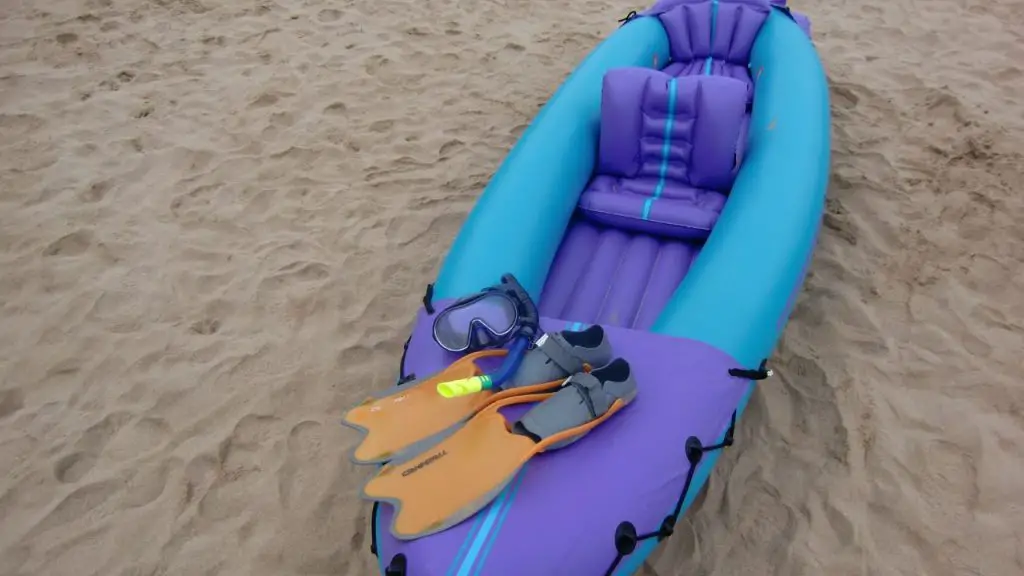
Handling & Maneuverability
A fully inflated kayak is as maneuverable as its hard-hull counterparts. That is because of rigidity and stability achieved once the air has filled all the pockets. You have nothing to worry about, even in rough ocean waters.
Inflatable kayaks are easy to handle and maneuver. Even novice paddlers will not find it challenging to control their boats. But as mentioned earlier, ensure you go for a long, wide inflatable kayak. It is the best for ocean waters.
Degree of Buoyancy
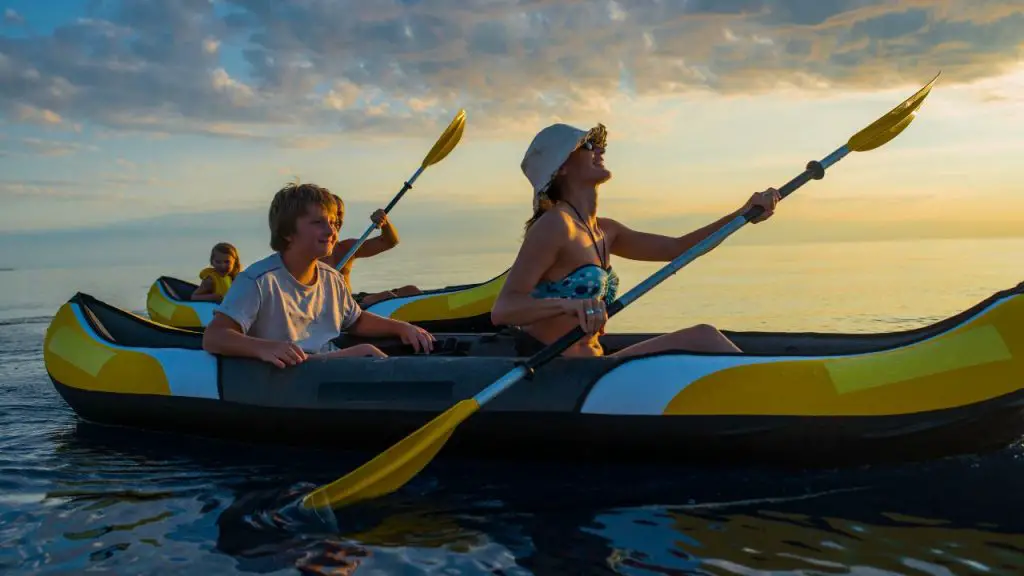
Inflatable kayaks are the best to stay afloat compared to hard-hulled ones. The air inside makes them more buoyant. As long as your boat has no punctures, it can stay afloat.
Also, you can easily remove water from them if they ever capsize. It is not a daunting task as it is with other kayak types.
What is The Best Inflatable Kayak For?
Inflatable kayaks can handle rough ocean waters but are not the best choice. They may not withstand extreme conditions and killer waves because they are lightweight. Strong winds and water currents can sway them away.
Besides, inflatable kayaks cannot withstand repeated hits from rocks. That is why you should carry your puncture repair kit. But to avoid that, use your inflatable kayaks for the activities that it best fits.
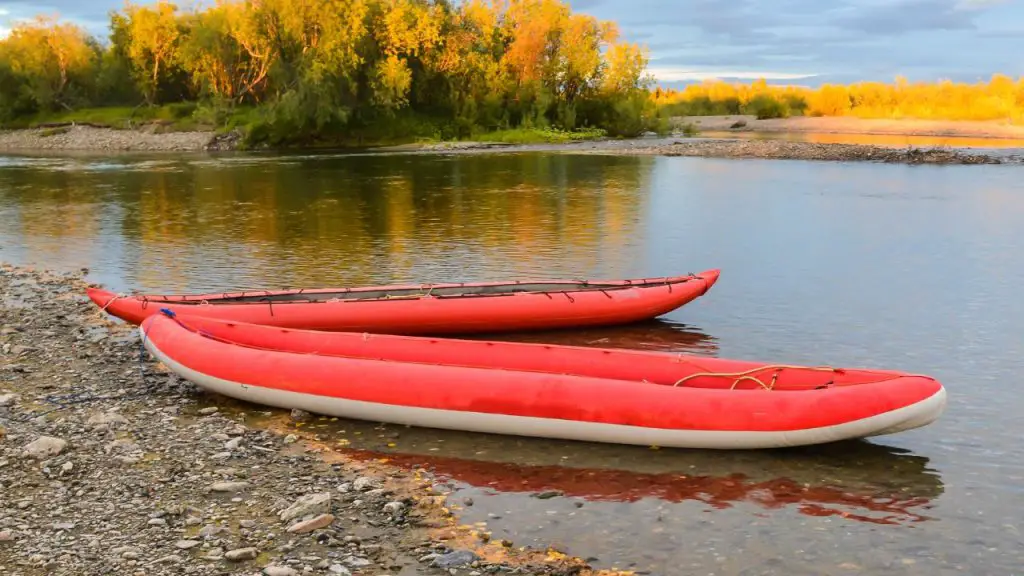
These kayaks and best suited for the following:
- Lazy paddling on a lake
- Kayak adventure expeditions
- Calm ocean inlet touring
- Whitewater kayaking
Hidden Water Hazards when Using Inflatable Kayaks In The Ocean
Inflatable kayaks are susceptible to many hidden hazards in the ocean. They include winds, water currents, and rocks.
Some sea-worthy inflatable kayaks can handle these conditions, provided you have the experience of kayaking through rough ocean waters. However, you should always be aware of these hazards to better avoid them.
Pros and Cons of Inflatable Kayak Used in the Sea
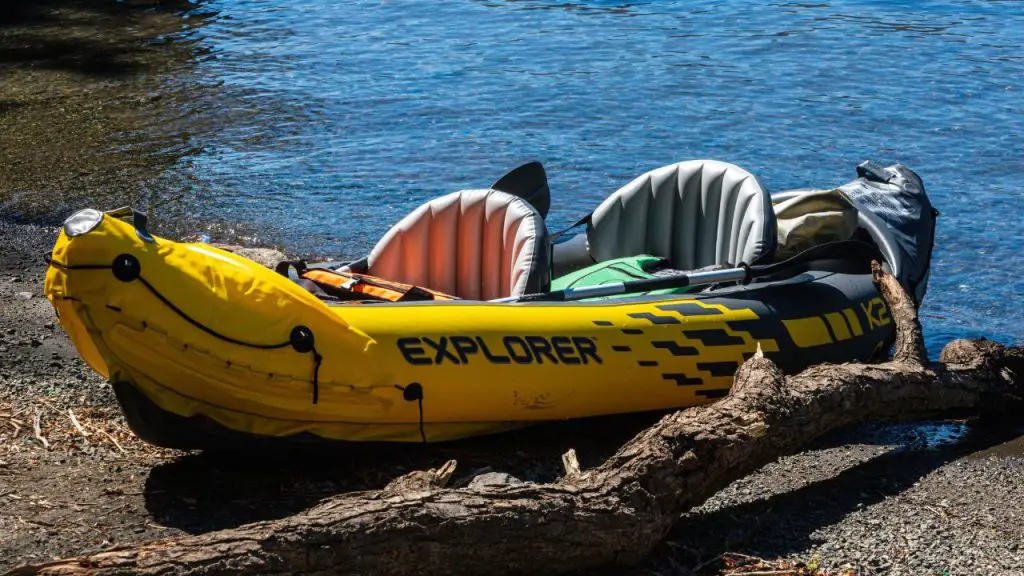
You should know the advantages and disadvantages of an inflatable kayak if you plan to use it in the sea. It may seem like the best option, but it presents some challenges, as highlighted below:
Pros:
- Lightweight and buoyant
- Highly portable
- More affordable than hard-hulled kayaks
- More stable and comfortable for beginners
Cons:
- Inflating and deflating take time
- Not ideal for top-speed kayaking
- Wind and water currents can easily sway them away
- Not immune to puncture
Requirements for Inflatable Kayaks in the Sea
Your inflatable kayak for use at sea should meet some specifications for stability, maneuverability, and handling. So, if you are shopping for an inflatable kayak, consider the following:
Long And Wide
Long and wide kayaks are more stable and can resist waves at sea. This rule also applies to hard-shell boats. Never choose a short and narrow kayak if you have the former option. That is because the latter option is easily swayed away by the wind, making them challenging to paddle.
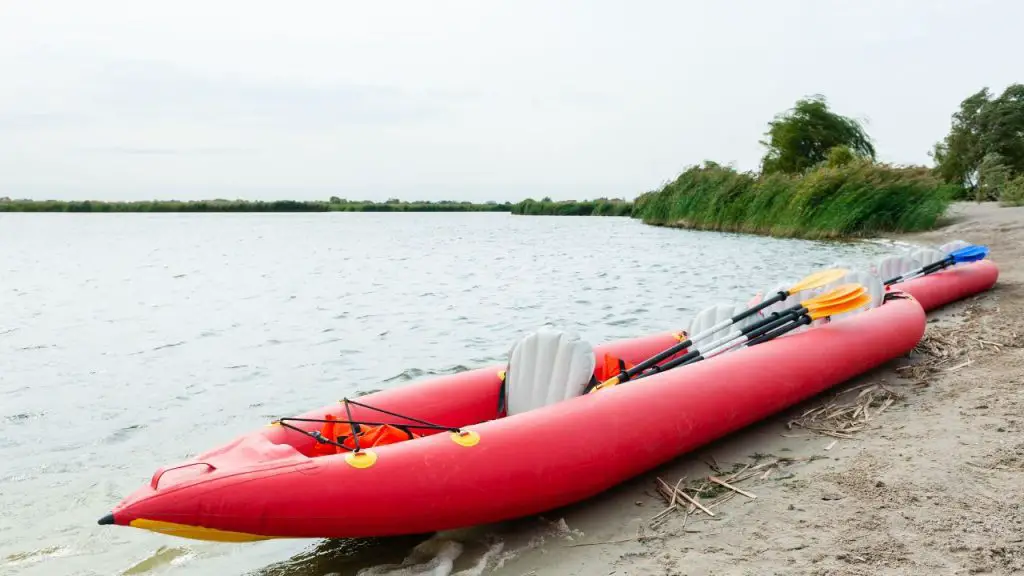
High-Pressure Air Floor
High-pressured kayak floor makes it more rigid and stable. You need it to match the flow and pressure of water in the sea. Remember that the pressure varies depending on where you kayak. Lakes have lower water flow and pressure than oceans and seas.
Self-Bailing Kayaks
Self-bailing is a must-have feature of any inflatable kayak for use at sea. Water in the sea or ocean can unexpectedly turn rough. Ocean waves can fill your boat in no time. And if you cannot drain the water fast enough, a disaster may strike.
Buy a self-bailing inflatable kayak to save time doing it yourself when more threatening waves are approaching your boat in the middle of nowhere.
Have Skeg
A skeg is a rigid plastic fitted on the underside of an inflatable kayak to guide it in a straight line when kayaking. It increases the maneuverability of your boat even in challenging conditions such as water currents or wind.
A skeg is your weapon to help you break through ocean tides and waves. Without it, the boat will struggle to reach its destination.
Best Inflatable Kayaks in the Sea
Inflatable kayaks designed for the sea exist, but some are better performers than others. The following are the most recommended options to consider:
Advanced Elements AdvancedFrame Convertible
This inflatable kayak is designed with an aluminum frame to improve rigidity and tracking. Additionally, it is built with three layers of puncture-resistant material to enhance its reliability in rough waters.
All the parts come pre-assembled at the factory. You only need to fix its adjustable padded seats!
Sevylor Coleman Colorado 2-Person
The Sevylor Coleman Colorado 2-Person is the most expensive of the three inflatable kayaks recommended. However, you get the reward for stability, durability, and reliability. It is also designed for aesthetics, featuring a 1000D tarpaulin bottom and 840D nylon cover.
It is designed with multiple air chambers and other features that make it more than a recreational kayak. It is ideal for fishing in any water.
The Sevylor Coleman Colorado 2-Person kayak has fishing rod holders, paddle holders, and motor fittings.
Sea Eagle Explorer 420x
Explorer K2 Kayak is designed for ultimate comfort when paddling. Like the previous product, this one comes with adjustable seats with backrests and a spacious cockpit.
This kayak has a directional skeg to allow you to paddle in a straight line through ocean waves and tides. However, it is not the best choice if you frequently kayak in the ocean and seas.
Inflatable Kayak Tips In The Ocean
Inflatable kayaks come with many advantages and can serve you for many years. But that is only possible if you can take good care of it and maintain it as instructed by the manufacturer. Also, you should be careful when using it.
The following are some tips to consider when using your inflatable boat:
- Don’t run into sharp objects to avoid punctures.
- Don’t drag it over rocks and gravel unless there is no other option. If it does puncture, seal it up immediately using a water-sealing compound or any other appropriate patching kit.
- Don’t disturb the wildlife during your adventure.
- Don’t bring alcohol to the kayak.
- Avoid waves on your way.
- Bring enough clean water for yourself so that if something happens (a puncture) then at least one person will have some way to drink until help arrives or they can get back into their own boat safely!
- Be careful when standing up in order switch places because stability may go away quickly- try not t odo anything too risky while swapping positions.
- Have a paddle leash
- Wear a whitewater PFD
- Stay as close to shore as possible in case you get a puncture.
- Have safety gear for ocean kayaking on board
- Wear a reliable life jacket to keep you safe if your kayak capsizes.
- Carry Map and GPS for easy navigation.
- Self-rescue devices
J-B Weld 8277 WaterWeld Epoxy Putty Stick – 2 oz.
What Kind of Kayak Should You Use in The Ocean?
Touring kayaks or sea kayaks are the best for kayaking expeditions in the ocean. These sit-in kayaks offer you the best protection from weather elements and nature. Most of your body parts are covered within the boat.
Most touring kayaks are designed for long journeys across the ocean. Their hulls are rigid and remain stable for exceptional handling and maneuverability.
You can also try sit-on kayaks if you want a better experience. However, you will be exposed to elements, including water under your feet.

FAQs
Which inflatable kayak is best for the sea?
Inflatable kayaks for the large ocean and sea waters are unlike other inflatable boats for general use.
These are designed for ocean waves, tides, and winds that ocean kayakers often experience. You can consider the recommended inflatable kayaks in this article.
Can you use a recreational kayak in the ocean?
Yes. Some recreational kayaks are designed for use in the calmer sections of ocean waters near the beach. Regardless, never leave your life jacket behind, and you may also require the help of a coast guard if you are a novice.
Is it safe to fish in an inflatable boat?
Yes. Some inflatable kayaks are ideal fishing vessels in different waters. But dangers or risks become higher when fishing with an inflatable kayak in the ocean or sea.
Wrapping Up
Inflatable kayaks are easy to store and transport and cost-effective compared to hard-hull ones. However, they are not the best choice for kayaking in rough waters. They can be swayed by wind and water currents.
So, if you want one to use in the ocean, go for inflatable kayaks specifically designed for water. Check that it has all features highlighted in this article.
Thank you for reading this post to the end. We hope you have found it informational and would gladly share it with your fellow kayakers. Also, explore the site for related content.





